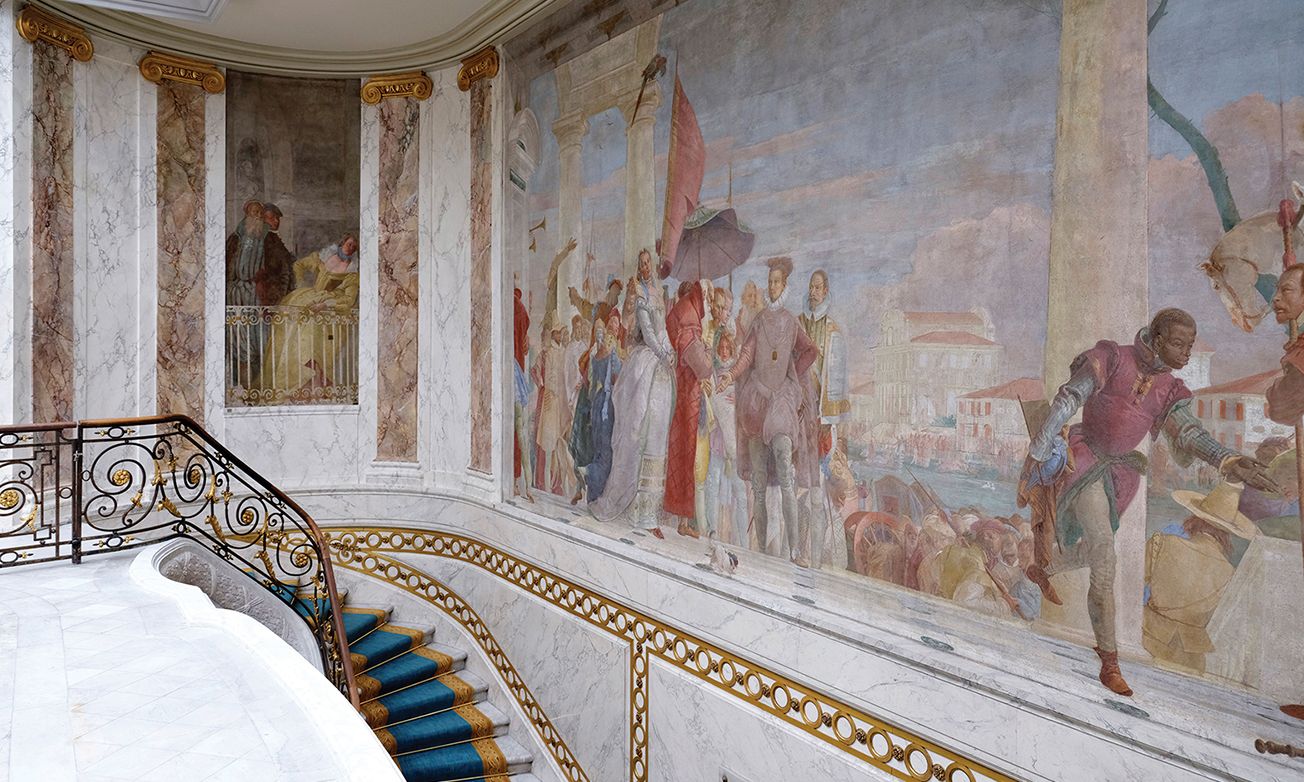Fit for a king: Tiepolo’s fresco Henri III Being Welcomed to the Contarini Villa (around 1745) at the top of the Jacquemart-André’s double helix staircase
© Culturespaces, Nicolas Héron
Anyone in Paris wishing to eat and drink beneath a ceiling by Giambattista Tiepolo, surrounded by priceless 18th-century tapestries from Brussels depicting the story of Achilles, can do so at the Musée Jacquemart-André from 6 September.
Situtated in the eighth arrondissement, at 158 Boulevard Haussmann, the former private mansion has been closed for a year while undergoing a spectacular renovation. It reopens this month.
“We have spent €6.5m and carried out extensive work,” explains the museum’s curator, Pierre Curie. “But rest assured, it is very much the same museum. I am, after all, a conservateur,” he continues, using the French title.
The spare-no-expense architect of the Musée Jacquemart-André was determined to outperform his arch-rival’s recently commissioned Paris opera house
© Culturespaces, Nicolas Héron
One of the most stunning private-house museums in Paris, the property was originally built for the wealthy banker Edouard André between 1869 and 1875. As a project in which no expense was spared, it also provided an opportunity for its architect, Henri Parent, to get back at his rival, Charles Garnier, who had just won the commission to create the city’s new opera house. Parent set about creating a state-of-the-art home with spaces for entertaining. The mansion incorporated hydraulic partition walls that could rise and fall on demand, and a double helix staircase that is one of the finest of its kind.
The staircase, itself a triumph of engineering, is finished with faux marble and gold decoration, whose crowning touch, installed in 1893, was a series of Tiepolo frescoes for its stairwell and ceiling. They were originally made for Villa Contarini in the Veneto and brought back to Paris by André, along with the ceiling for the dining room. The frescoes, which show Henri III returning from Poland to succeed to the French throne, were restored in 1998.
André (1833-94) began collecting art as a young man. “He liked French art from the 18th century—Fragonard, Boucher—as well as decorative arts and tapestries,” Curie says. “But he developed his tastes once he married Nélie Jacquemart in 1872.”
Jacquemart was a successful portrait painter who had shown at the Paris Salon from the age of 22 and had a taste for the Italian Renaissance. The couple travelled extensively in Italy and acquired pictures and sculptures in Milan and Rome. The spoils of their tours can be seen throughout the house, including masterpieces such as Paolo Uccello’s Saint George and the Dragon (1430-35) and works by Andrea Mantegna and Giovanni Bellini alongside sculptures by Donatello.
They also looked more widely. In the collection are incredible works by Rembrandt: Supper at Emmaus (around 1629), Portait of Princess Amalia van Solms (1632) and Portrait of Dr. Arnold Tholinx (1656) as well as paintings by Flemish masters.
André first met Jacquemart when she was commissioned to paint his portrait in 1862. “She was a naturalist painter,” Curie says. “She worked from photographs and made preparatory drawings.”
They married ten years later, encouraged by André’s family. André was a notorious rake, racked by syphilis and known for keeping company with prostitutes. Jacquemart was seen as a steadying influence, although it is unlikely that the marriage was ever consummated.
Curie came to the museum in 2016, attracted by its Italian and French works. “It was only open for a few weeks a year then,” he says. “But I knew several parts of the museum needed a lot of work.”
When the decorative ceiling of the smoking room began to fall away, the decision was finally made to take things in hand. “It was becoming dangerous,” Curie says. Since September 2023, the building has been full of restorers. “Sometimes 20 or more people a day, working on their highly specialised tasks,” he says. The funds came from the museum’s independent owner, the Institut de France, via the Jacquemart André Foundation.
Now the walls of the smoking room, which were covered in a green silk, have been reupholstered in claret-coloured fabric—a fire-resistant synthetic that imitates silk satin. The exact shade was matched from a 1913 colour photograph. “We scanned it and managed to reproduce it,” Curie says. In the mansion’s former dining room, the walls have been restored to their original light grey-green, discovered beneath coat after coat of paint.
The museum’s temporary exhibition spaces invariably host displays of historic Italian art, in keeping with the original owners’ predilections. Fittingly, the reopening show will feature Renaissance and Baroque masterpieces from the Galleria Borghese in Rome, including Titian’s Venus Blindfolding Cupid (around 1565) and Caravaggio’s Boy with a Basket of Fruit (around 1595)—works which are rarely loaned outside of Italy.

